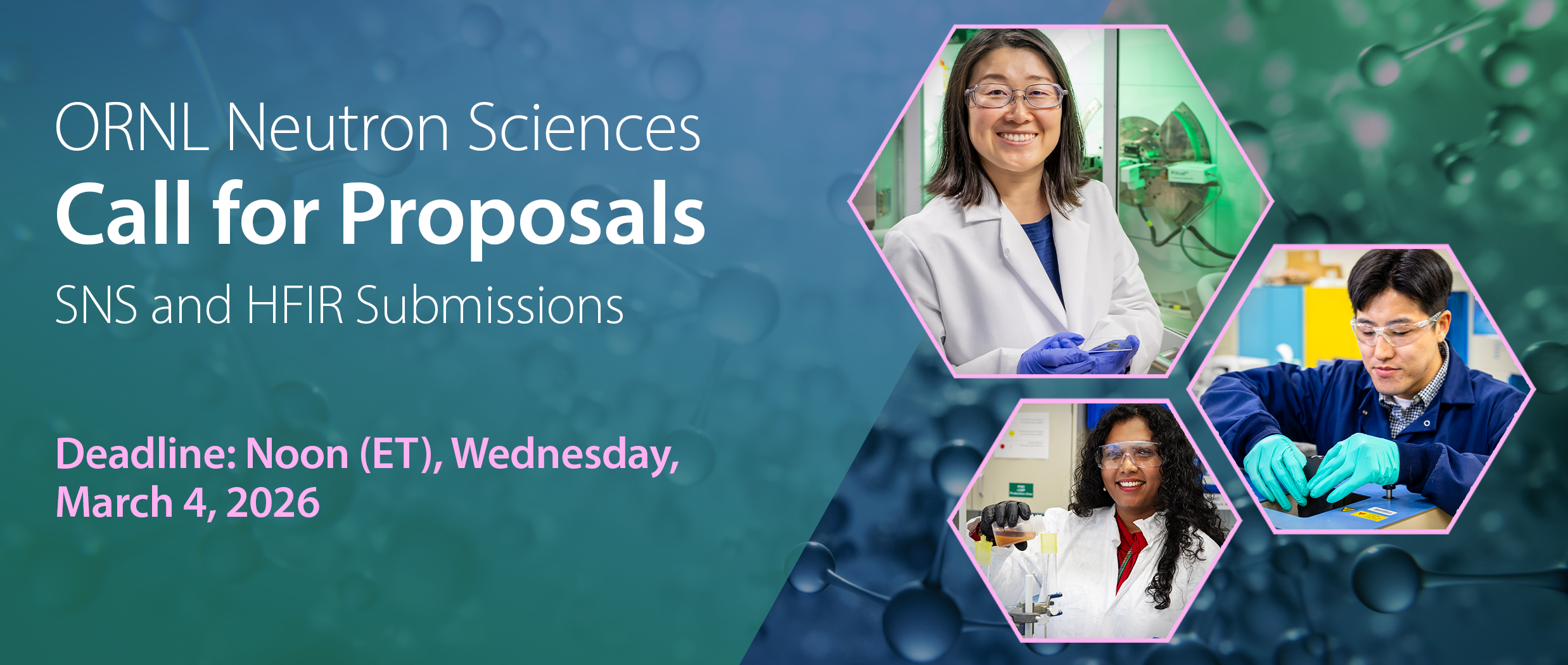Proposal Calls
2026-B General User Proposal Call
Submissions for the 2026-B General User Proposal Call are open for experiments to run at HFIR and SNS between July - December 2026. The deadline is March 4, 2026.
ORCID iD Requirements
The Department of Entergy (DOE) national laboratories, user facilities, and laboratory libraries collect and use ORCID iDs to track research outputs and awards, determine the impact of user facilities, and evaluate the outcomes of outreach efforts. Facility users will be required to connect their ORCID iD in the ORNL Guest Portal to submit proposals and participate in experiments. If you haven’t yet connected your ORCID iD, after you log into the ORNL Guest Portal click on “Create or connect your ORCID iD". Visit the ORCID website to learn more about ORCID iDs and to register for your account.
New User Beamtime (NUBe) Program
The NUBe program aimed at growing the neutron scattering user community and increasing the scientific and institutional diversity of our user base. Time will be allocated for NUBe proposals on each instrument participating in this call. For eligibility in this program, the Principal Investigator must hold a permanent position at their institution (i.e., any rank of faculty member or staff). Undergraduates, graduate students, and post-docs are not eligible, but may participate as collaborators on the proposal. See the the New User Beamtime (NUBe) program webpage for more information.
Experiment Lead Role and PI requirements
The Principal Investigator (PI) listed on a proposal must be the team member who has overall responsibility for the research group and someone who holds a permanent position at their institution, such as Assistant Professor, Professor, Research Scientist or Professional Staff. The Principal Investigator (PI) role can only be assigned to an individual with an active IPTS account. See Step 5 on the How to Submit a Proposal webpage for instructions to create an account.
A new Experiment Lead role is now available to indicate a co-primary contact on a proposal. A team member who is Undergraduate, Graduate or Post-doctoral Research Associate and who is serving as primary contact for experiment planning and/or conduct should be designated the Experiment Lead. The Experiment Lead has the same proposal access as the PI. The Experiment Lead can edit a proposal, confirm a proposal awarded beam time, add samples, and add team members. The Experiment Lead is copied on all proposal-related messages sent to the PI.
Every proposal must have a PI. Experiment Lead is an optional role but, if used, there can be no more than one Experiment Lead designated.
User Participation Expectations
User engagement is essential to the success and productivity of our User Program. Awarded Principal Investigators are expected to participate in the experiment onsite or remotely by providing real time directions to the team. At least two users from the team should plan to participate in the experiment onsite. In some cases, remote participation may substitute for onsite participation depending on experiment complexity. Please discuss your participation plans with the instrument team in advance.
Mail-In Program Expansion for HFIR and SNS Instruments
Mail-In proposals are available as a rapid access mode outside of our bi-annual proposal calls, and can be submitted in IPTS anytime. Mail-In proposals are limited to one day experiments, in which users send samples by mail for instrument staff to collect data on the user's behalf. Mail-in experiments are expected to contribute to a publication, unlike Proof of Principal proposals which are available for testing the feasibility of a potential experiment. Mail-In proposals should be submitted for the cycle in which you anticipate samples being ready to send for analysis. We have recently expanded the program to 11 instruments at HFIR and SNS: ARCS, EQ-SANS, GP-SANS, HYSPEC, NOMAD, POWGEN, SEQUOIA, SNAP, VISION, VULCAN, and WAND². Visit the individual instrument web page for more information about the Mail-In proposal requirements for that instrument, and to download an instrument specific Statement of Research template (if available).
Center for Nanophase Materials Science (CNMS) Resources Available
The Center for Nanophase Materials Science (CNMS) provides access to staff expertise and state-of-the-art equipment for a broad range of nanoscience research, including nanomaterials synthesis and deuteration, nanofabrication, imaging/microscopy/characterization, and theory/modeling/simulation.
New CNMS features in IPTS: Requests for CNMS characterization time and/or chemical deuteration support can be made from the Other Experiment Resources step during proposal submission. In this step, users interested in CNMS support can select from a menu of deuterated monomers and request information from CNMS about other available services. Eight Deuterated Monomers are available to be requested through CNMS. This feature is now available in IPTS.
Questions about the CNMS facilities can be submitted to cnmsuser@ornl.gov. Users may also submit a proposal directly to CNMS.



